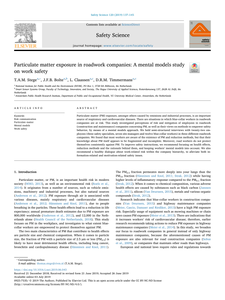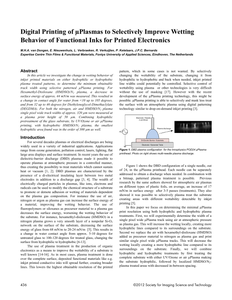Thank you for sharing this story! However, please do so in a way that respects the copyright of this text. If you want to share or reproduce this full text, please ask permission from Innovation Origins (partners@innovationorigins.com) or become a partner of ours! You are of course free to quote this story with source citation. Would you like to share this article in another way? Then use this link to the article: https://innovationorigins.com/en/silicon-sampling-ai-powered-personas-offer-new-insights-for-market-research-but-have-limitations/ n the rapidly evolving field of marketing and communication, staying ahead means embracing technological innovations. The latest breakthrough, silicon sampling, leverages AI to revolutionize market research by creating synthetic personas that mimic human responses. This method, which utilizes large language models (LLMs) like GPT-4o, offers a cost-efficient and less time-consuming alternative to traditional market research. Roberta Vaznyte and Marieke van Vliet (Fontys University of Applied Science) have explored the promise and challenges of silicon sampling, highlighting key findings from recent experiments and the implications for the future of market research.
LINK
From the article: "A facile approach for the fabrication of large-scale interdigitated nanogap electrodes (nanogap IDEs) with a controllable gap was demonstrated with conventional micro-fabrication technology to develop chemocapacitors for gas sensing applications. In this work, interdigitated nanogap electrodes (nanogap IDEs) with gaps from 50–250 nm have been designed and processed at full wafer-scale. These nanogap IDEs were then coated with poly(4-vinyl phenol) as a sensitive layer to form gas sensors for acetone detection at low concentrations. These acetone sensors showed excellent sensing performance with a dynamic range from 1000 ppm to 10 ppm of acetone at room temperature and the observed results are compared with conventional interdigitated microelectrodes according to our previous work. Sensitivity and reproducibility of devices are discussed in detail. Our approach of fabrication of nanogap IDEs together with a simple coating method to apply the sensing layer opens up possibilities to create various nanogap devices in a cost-effective manner for gas sensing applications"
MULTIFILE

Conclusion and general discussion regarding brokers in the SME network across Design and High-tech industries
DOCUMENT
Particulate matter (PM) exposure, amongst others caused by emissions and industrial processes, is an important source of respiratory and cardiovascular diseases. There are situations in which blue-collar workers in roadwork companies are at risk. This study investigated perceptions of risk and mitigation of employees in roadwork (construction and maintenance) companies concerning PM, as well as their views on methods to empower safety behavior, by means of a mental models approach. We held semi-structured interviews with twenty-two employees (three safety specialists, seven site managers and twelve blue-collar workers) in three different roadwork companies. We found that most workers are aware of the existence of PM and reduction methods, but that their knowledge about PM itself appears to be fragmented and incomplete. Moreover, road workers do not protect themselves consistently against PM. To improve safety instructions, we recommend focusing on health effects, reduction methods and the rationale behind them, and keeping workers’ mental models into account. We also recommend a healthy dialogue about work-related risk within the company hierarchy, to alleviate both information-related and motivation-related safety issues. https://doi.org/10.1016/j.ssci.2019.06.043 LinkedIn: https://www.linkedin.com/in/john-bolte-0856134/
DOCUMENT

SMEs within the rural Dutch municipality of Utrechtse Heuvelrug (UHG) are becoming increasingly aware of the need for sustainable ‘green’ business. Their sense of sustainability is strongly defined by the ‘green’ environment in which they live and work. They were seeking an entrepreneurial approach to sustainability that is reflective of the area and fits their ecosystem. This approach was to be aimed at innovation and branding. We assumed that the role and function of a location-based brand differs from that of product or corporate brands because it has more complexity. Taking place-branding theory as our starting point, we set out to construe a brand that is a) based on local identity and b) has the power to motivate and mobilize SME entrepreneurs to form cooperative sustainable networks. This paper presents our analysis for a brand framework and demonstrates how it has been applied to imbue sustainable ‘green’ impact.
DOCUMENT

In this article we investigate the change in wetting behavior of inkjet printed materials on either hydrophilic or hydrophobic plasma treated patterns, to determine the minimum obtainable track width using selective patterned μPlasma printing. For Hexamethyl-Disiloxane (HMDSO)/N2 plasma, a decrease in surface energy of approx. 44 mN/m was measured. This resulted in a change in contact angle for water from <10 up to 105 degrees, and from 32 up to 46 degrees for Diethyleneglycol-Dimethaclylate (DEGDMA). For both the nitrogen, air and HMDSO/N2 plasma single pixel wide track widths of approx. 320 μm were measured at a plasma print height of 50 μm. Combining hydrophilic pretreatment of the glass substrate, by UV/Ozone or air μPlasma printing, with hydrophobic HMDSO/N2 plasma, the smallest hydrophilic area found was in the order of 300 μm as well.
DOCUMENT

Assistive technology supports maintenance or improvement of an individual’s functioning and independence, though for people in need the access to assistive products is not always guaranteed. This paper presents a generic quality framework for assistive technology service delivery that can be used independent of the setting, context, legislative framework, or type of technology. Based on available literature and a series of discussions among the authors, a framework was developed. It consists of 7 general quality criteria and four indicators for each of these criteria. The criteria are: accessibility; competence; coordination; efficiency; flexibility; user centeredness, and infrastructure. This framework can be used at a micro level (processes around individual users), meso level (the service delivery scheme or programme) or at a macro level (the whole country). It aims to help identify in an easy way the main strengths and weaknesses of a system or process, and thus guide possible improvements. As a next step in the development of this quality framework the authors propose to organise a global consultancy process to obtain responses from stakeholders across the world and to plan a number of case studies in which the framework is applied to different service delivery systems and processes in different countries.
DOCUMENT

Purpose: This research aimed to explore factors associated with patient-reported breast and abdominal scar quality after deep inferior epigastric perforator (DIEP) flap breast reconstruction (BR). Material and Methods: This study was designed as a descriptive cross-sectional survey in which women after DIEP flap BR were invited to complete an online survey on breast and abdominal scarring. The online survey was distributed in the Netherlands in several ways in order to reach a diverse population of women. Outcomes were assessed with the Patient Scale of the Patient and Observer Scar Assessment Scale (POSAS). Additional items were assessed with a numeric rating scale (NRS). Results: A total of 248 women completed the survey. There was a statistically significant worse POSAS scar appraisal for the abdominal scar compared with the breast scar. The vast majority of women reported high scores on at least one scar characteristic of their breast scar or ab- dominal scar. Overall, color, stiffness, thickness, and irregularity scored higher than pain and itching. Women were only moderately positive about the size, noticeability, location, and the information provided regarding scarring. Conclusion: It is crucial to address the inevitability of scars in patient education before a DIEP flap BR, with a particular focus on the abdominal scar, as women experience abdominal scars significantly worse than their breast scars. Providing more information on the experience of other women and the expected appearance will contribute to having realistic expectations while allowing them to make well-informed decisions.
DOCUMENT

Breast cancer is the most prevalent form of cancer that affects women worldwide, posing a significant burden on public health. While advancements in early detection and improved treatments have led to a remarkable 90% five-year survival rate and an 83% ten-year survival rate, this has also resulted in more prophylactic mastectomies being performed. Despite advancements in breast-conserving techniques, immunotherapy, and hormone therapy, many women still undergo mastectomies as part of their cancer treatment. In all cases, this results in scarring, and additional side effects from treatment modalities may arise. The loss of a breast can profoundly impact health-related quality of life (HRQoL). Although HRQoL has improved greatly during the recent years, systematic and local therapy having side effects is not uncommon, and this needs more attention.
DOCUMENT
